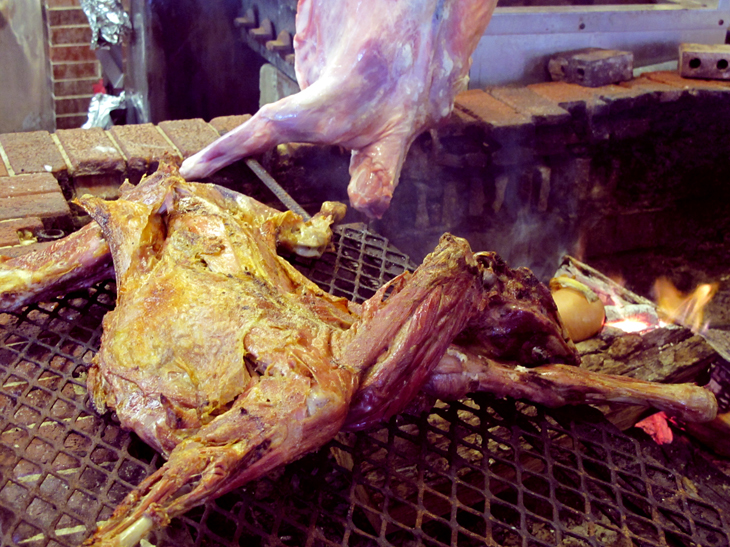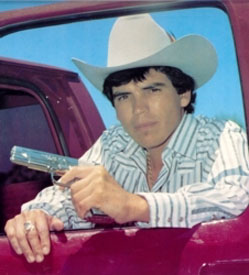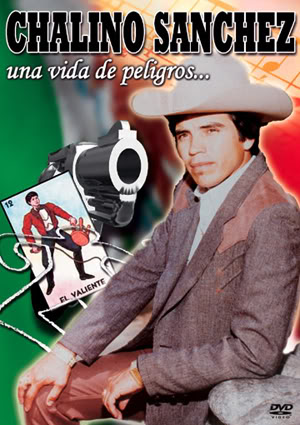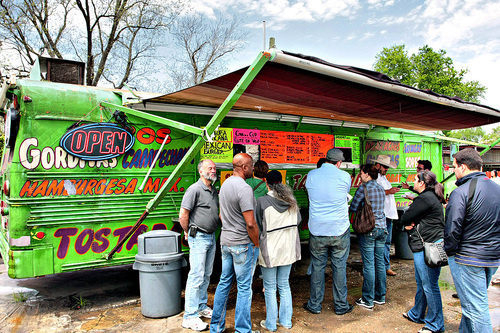Cooking Underground: How It’s Done
If you’re interested in cooking lamb (borrego) or goat (cabrito) in an underground firepit, I came across this video that shows you how the real vaqueros do it in Hidalgo. Enjoy.
January 15th, 2011 in Taco School by Jay | no responses
If you’re interested in cooking lamb (borrego) or goat (cabrito) in an underground firepit, I came across this video that shows you how the real vaqueros do it in Hidalgo. Enjoy.
January 15th, 2011 in Tacos! by Jay | no responses
 This article was previously posted on 29-95.com.
This article was previously posted on 29-95.com.
Earlier this year, I was introduced to a guy named John Speights; an astute homebrewer, Mexican food aficionado, and fanatic of weird music. While enjoying a Hoppin’ Frog B.O.R.I.S. Oatmeal Imperial Stout in his backyard, I spotted a large circular brick oven, similar to the description in Robb Walsh’s The Tex-Mex Grill and Backyard Barbacoa Cookbook.
“What the hell is that thing?”
“This, my friend, is a brick oven. I use it to cook baby lambs.”
I knew right away that we would be amigos, and that we would share mix tapes, ride bicycles together, and knit one another friendship bracelets.
He explained the process in detail. Before the firepit is built, a large hole is dug out of the ground, and a concrete base is poured in, leaving about a foot and a half of depth. A car tire is used to facilitate pouring the mold. The pit isn’t made of stone bricks, but “fire bricks”, constructed of a ceramic material similar to the inside of a kiln. A special heat-resistant mortar is used when stacking the bricks concentrically. A tight seal is important, so if the bricks or mortar eventually crack, you can use mud to pack in between the cracks. I won’t get into too much detail about the construction of a fire pit, because it’s all over the web and I am not your personal research assistant.
The cooking process can take up to three days. A big fire is lit within the pit, until the bricks are at the correct temperature. At this time, you let the fire burn itself out. A mesh grill is installed over the coals, a pot is placed on top of the grill to collect the meat drippings for birria (a lamb or goat consommé) and another grill is installed above to cook the innocent baby lamb. Although there are countless methods of cooking lamb, he learned this style from his friends in Hidalgo, Mexico.
Leaves of the maguey plant are cut and split, and the seasoned lamb cuts are wrapped in these leaves and tied off with string. You can find these yucca-like leaves in Hispanic produce markets (John prefers to grow his own). John uses lamb testicles in his consommé, along with rice, garbanzo beans, garlic, epazote, and chipotle peppers. Once everything is in place, a tight lid is placed on top and situated so that no air escapes from the pit. Then you just leave it alone for a long, long time and revel in your manliness, because you’re on your way to becoming a true-life backyard badass.
You can do the same thing with goats.
The proprietors of El Hidalguense reign from Hidalgo, a Mexican state rich with historical and gastronomic significance. The name means “guy from Hidalgo”, kind of like you’d call a guy from Texas a Texan. As the case with a great many Mexican restaurants around town, this business started as a food truck and eventually flourished into a full-blown restaurant.
Dr. Jocelyne Gonzalez is a daughter of El Hidalguense’s owners and a friend of mine. We talked about goats once.
“Eat at my parents’ restaurant, or I will kill you with a knife”, she stated grimly, without a hint of sarcasm or humor, while holding a large knife.
El Hidalguense is on Long Point, and as any Houston food adventurer worth their salt knows, is a vast stretch of cultural cuisine. You could eat there every day and never find everything. In fact, it’s a hotspot for Houston Culinary Tours, where people throw down big bucks to hang out with celebrity chefs and chow down on unique foods from around the world. The restaurant is about a block from Taqueria el Ultimo, which is known as one of the greatest taco trucks in the city. In fact, Ultimo was listed in Walsh’s Top Ten a few years back; and very recently, listed as one of The South’s Best Food trucks by Southern Living Magazine. That’s probably why I had never tried El Hidalguense before, or at least that’s my excuse. Driving past Ultimo has always been a cardinal sin.
Several things draw your attention when you walk into El Hidalguense. If you come in on a Saturday or Sunday, you’ll find live music by Trio Alacran Hidalguense, singing and playing in the huapango style. This band is fantastic. The fiddle player’s hands and instrument are coated with chalk dust, and the horse hair of the bow splits into the air as the vocalist conjugates Spanish verbs like a Mexican Nusrat Fateh Ali Khan.
You’ll see old cowboy hats hanging on the wall that look as if they’ve traveled through deserts, mountains and trail dust for decades. And the most exciting thing (to me, anyway) is the brick firepit where they smoke fresh cabrito (young goat). Their recipes and cooking methods were handed down from Josey’s grandmother in Hidalgo a while back.
If it’s your first time at El Hidalguense, you’re going to want some cabrito. You can choose between cabrito asado (barbeque); or cabrito enchilados, a method where the meat is wet-rubbed with a powder ground from dried chiles. A cabrito plate will set you back about $27, but it is plenty to eat, enough to split with a companion. The plate is a combination of shoulder, ribs, head meat, and if you’re lucky, a kidney or two. If you’re new to cabrito, the aroma can seem a little odd, but once you see the meat fall off of the bone and dig in, you’ll be a believer. After all, goat is by far the most popular meat in the world, and consumed by 75% of the world’s population. Its fat content is 50%-65% lower than similarly prepared beef, but you’ll never notice. I enjoy making cabrito tacos with the accompanying handmade corn tortillas, topped with their smoky salsa, cleverly constructed with Arbol Seco and Morita chiles.
The slow-cooked cabrito is El Hidalguense’s specialty, but the lamb is spectacular as well. Order the barbacoa de borrego (lamb barbacoa), or the spicy nopales (cactus) and puerca (ground pork) gorditas, paired with an icy Tecate. The birria is excellent as well, sopped up with fresh handmade corn tortillas aplenty. If you’re feeling really adventurous, go straight for the cabeza. Yes, it’s a baby goat’s head, right there on your plate, split down the middle so you can get to the sesos (brains). I’m not a fan of sesos, but these are the best I’ve had. The real treat is the goat’s tongue, which is so fantastic that you don’t want to compromise the taste by adding salsa.
If you show up on the right day, you may even be lucky enough to come across Jay Francis, a prominent yet controversial Houston food explorer who is skilled in the sacred art of brujeria. At the Houston Chowhound’s Taco Truck Crawl III, he actually got it to stop raining by doing some weird chanting stuff with small animal bones while making clucking noises.
The restaurant will take your plastic, but bring a few bucks to tip the band. Bring your family or friends along on a weekend, and you’ll all have great food and an authentic Mexican experience. I brought Jonathan Jones, chef of Beaver’s and El Patio to the restaurant, and he told me, “Of all the Mexican restaurants in the Houston area, this is the most Mexican.”
It would be tough not to agree with this. Enjoy the photos!

January 12th, 2011 in Insanity! by Jay | no responses
I’ve been a huge fan of McSweeney’s Books for years, and they promote these Wholphin DVD’s on their site. These are collections of movie shorts from around the world, some of them extremely odd (or awful), and some extremely amazing. I picked up a few, and one of the short films blew my mind. It’s called “Walleyball”, and it shows US folks playing volleyball over the border fence with Mexican folks. I remember this fence very well- when living in Tijuana, we would frequently head to this beach. Young boys would bring coolers of Cerveza Sol and Dos Equis around and sell them for a buck or two (though no glass containers were allowed on the US side.) Try to ignore the annoying narrator, and enjoy the ironic beauty of a simple volleyball game among unlikely friends. (Music by Aesop Rock.)
December 19th, 2010 in Tacos! by oberata | 2 responses
The following is a guest post from my friend Jeff Timpanaro. He’s got five kids, and he needs a new kidney due to an odd condition called Lupus. If you can’t give him a kidney, buy this guy a camera because his taco photos are terrible. Also, be sure and check out his website.
Enjoy! – G&T
It was one of those days that I’m embarrassed to admit how little I had to do. 3/5 of my kids were at school, while the other two were playing the blood- pressure-skyrocketing game of Hi-Ho-Cherry-O Confetti, where pea-sized cherries from the popular board game become projectiles, choking hazards, and eventually painful foot-lodgings. O childhood gaiety.
pressure-skyrocketing game of Hi-Ho-Cherry-O Confetti, where pea-sized cherries from the popular board game become projectiles, choking hazards, and eventually painful foot-lodgings. O childhood gaiety.
I had to intervene.
Intervention, of course, meant getting my ass of the couch and setting aside my laptop. With Twitter full of commuter rage and work litanies, and our living room raining tiny cherries, I hatched my plan like any good parent: “TACO TRUCK!”
My Lil’ Taco Warriors (Lachlan, 3, and Vigo, 2) snapped to attention instantly upon hearing my plan. “TACO TRUCK? FIRST WE HAVE TO GET A TORTILLA, AND THEN WE EAT A PIZZA AND A QUESADILLA.”
However vague their recollection of how this worked, our team was amped to have an activity . . . like Phineas & Ferb’s signature saying, “Hey, I know what we’re gonna do today!”
October 15th, 2010 in Insanity! by Jay | one response
October 13th, 2010 in Insanity! by Jay | 9 responses
 I first (knowingly) heard Mexico’s famous North Mexican supergroup Los Tigres del Norte in a taxicab in Tijuana. It sounded like some kind of German polka, heavy on the accordion, and it seemed fairly unremarkable until samples of automatic gunfire erupted throughout the song. “What kind of music is this?” I asked the driver.
I first (knowingly) heard Mexico’s famous North Mexican supergroup Los Tigres del Norte in a taxicab in Tijuana. It sounded like some kind of German polka, heavy on the accordion, and it seemed fairly unremarkable until samples of automatic gunfire erupted throughout the song. “What kind of music is this?” I asked the driver.
“Ranchera”, he replied. “It’s Mexican gangster music”.
Growing up in Texas, it’s impossible not to be familiar with Tejano (Tex-Mex) music. Although somewhat similar to Tejano, ranchera was less refined in studio quality and entirely devoid of the North American “country music” sound. I eventually learned that ranchera is more “rural” than “gangster”.
Modern ranchera’s stepchild narcocorrido is gangster. The narcocorrido, or “drug ballad”, is a style of popular music throughout Texas and Mexico which generally focuses on aspects of the drug trade.
With its anti-authoritative tone and stories of violent gunfights, peppered by samples of gunshots and sirens, I was sold. The more I learned about this style of music, the more Mexico seemed like the Old West, bolstering its appeal. In the bars and nightclubs of Tijuana, the most affluent patrons sported white cowboy hats and gold chains. Years later, I’d see the same type of crowd in massive Houston nightclubs such as El Rodeo and El Chaparral.
Arguably, Rosalino “Chalino” Sánchez is the ultimate badass of the narcocorrido style. Born in Sinaloa, Mexico, he had a nightmarish childhood. After the untimely death of his father that threw his family into poverty, his sister Juana was raped by “El Chapo” Perez, a member of a local crime syndicate. Chalino dedicated his young life to revenge, and at 15, legend says, he gunned down Perez at a party in public view. On the run from Mexican authorities, he eventually crossed the border into Southern California.
Chalino employed himself on the streets, assisting his brother Armando as a coyote, drug dealer and dishwasher. His brother was shot and killed in a Tijuana hotel in ’84, and Chalino wrote his first known ballad as a memorial to his brother. He continued writing music and promoting himself with cassette tapes for months, until he was catapulted into stardom on one eventful night.
 That night, he was singing in a club in Coachella, California, just outside Palm Springs, when an unemployed mechanic came up to the stage to make a request, then pulled out a pistol and shot Chalino in the side. Living up to his reputation, Chalino pulled out his own gun and returned fire. By the time it was all over, the would-be assassin had been shot in the mouth with his own gun, Nacho Hernandez had been shot in the thigh, and at least five other people were wounded, including a young guy who bled to death as his friends drove him to the hospital. In Sinaloa, it is commonly said that the death toll was higher, but that most of the killed and wounded, being undocumented aliens with criminal connections, were spirited out of the club and over the border before the police arrived.
That night, he was singing in a club in Coachella, California, just outside Palm Springs, when an unemployed mechanic came up to the stage to make a request, then pulled out a pistol and shot Chalino in the side. Living up to his reputation, Chalino pulled out his own gun and returned fire. By the time it was all over, the would-be assassin had been shot in the mouth with his own gun, Nacho Hernandez had been shot in the thigh, and at least five other people were wounded, including a young guy who bled to death as his friends drove him to the hospital. In Sinaloa, it is commonly said that the death toll was higher, but that most of the killed and wounded, being undocumented aliens with criminal connections, were spirited out of the club and over the border before the police arrived.
-Elijah Wald, Narcocorrido: A Journey into the Music of Drugs, Guns, and Guerrillas
Sanchez’ voice was raspy and often out of tune, which helped define his “tough guy” sound over multitudes of imitators. He would antagonize prominent cartel leaders and public figures. A prolific musician, he cranked out thousands of cassettes and sold them in the streets. In Mexico and California, Chalino was known (and feared) as the real deal. He wore his white hat cocked to the side, a big belt buckle, cowboy boots, gold chains, and packed a Colt 45 with pearl grips.
At the height of Chalino’s success, according to most accounts, his entourage was pulled over by a Chevy Suburban. A number of men displayed police identification and asked that he accompany them to the police station. He was found hours later on the side of the road, blindfolded, with rope marks around his wrists and two gunshots to the head. There is some confusion as to where this information regarding the Suburban was credited. In LA Weekly’s cover article on the subject it was reported that Chalino’s brother Esperidon was the surviving witness – but according to this fan site, Chalino didn’t have a brother by this name.
Violence in the narcocorrido culture has often been compared with rap culture in the US. Just like Tupac and Biggie, several groups scrambled to purchase Chalino’s music, mixing his voice with their album tracks. LA Weekly referred to it as a “Sinaloazation of L.A.” Chalino had recently sold off his rights to a record company for around $150,000, and his family would see no royalties to the fortune.
Chalino’s legacy didn’t end there. His son Adán Sánchez was a very popular and successful singer since the age of 10, eventually selling out the Kodak Theater in Hollywood (home of the Academy Awards). At the age of 19, while on tour in Mexico, he was killed in a car crash in his father’s home state of Sinaloa while on tour. Although there are rumors that the car was gunned down, there isn’t much evidence around to back it up.
At the funeral proceedings for Adán, over 10,000 mourning fans crowded the streets in Norwalk, CA. As they were turned away at the church doors and the police arrived with riot gear, groups of angry fans rocked cars and turned over portable toilets. Years later, a stage play was written regarding the events of that day.
As the violence in Mexico increases, the ballads of the drug trade live on- and so does the violence in the music world. According to Wikipedia, over a dozen prominent Mexican musicians have been murdered between 2006 and 2008, most notably Valentín Elizalde, Sergio Vega, Sergio Gómez, the lead singer of Chicago-based Duranguense band K-Paz de la Sierra, and Sergio Vega (El Shaka). Largely, most of these murders have gone unsolved.
Sure, some of this music does tend to glorify violence. As the Mexican government attempts to put a stop to this unique music, their efforts obviously promote the opposite effect. Artists will continue to immortalize these stories with music- a format that will never be forgotten, as the cartel wars and headlines continue.
This video showcases the banda style, a fusion of German polka and Northern Mexican music which originated in Sinaloa. Also, I bet nobody is telling him to take his foot off the couch.
October 8th, 2010 in Insanity! by Jay | 2 responses
I’m honored to be nominated for CNN’s Heroes of the Year contest. If you don’t mind, please take a moment to vote for me by selecting the “Vote for Guns and Tacos” button below.
October 7th, 2010 in Insanity! by Jay | no responses
There are political signs all over the city, so I figured I’d make my own. Feel free to plaster all over the city, make a bandit sign for your front yard, or slap it on a sign to hold high at your favorite political rally.
August 12th, 2010 in Tacos! by Jay | 2 responses
 Remember Taco Truck Crawl #3? Matt Hardigree, news editor for the successful automotive site Jalopnik.com, brought his team along in two huge Ram 2500HD trucks. This morning Jalopnik told their story and included some helpful taco trucking instructions and great photos of the event. Check it out!
Remember Taco Truck Crawl #3? Matt Hardigree, news editor for the successful automotive site Jalopnik.com, brought his team along in two huge Ram 2500HD trucks. This morning Jalopnik told their story and included some helpful taco trucking instructions and great photos of the event. Check it out!